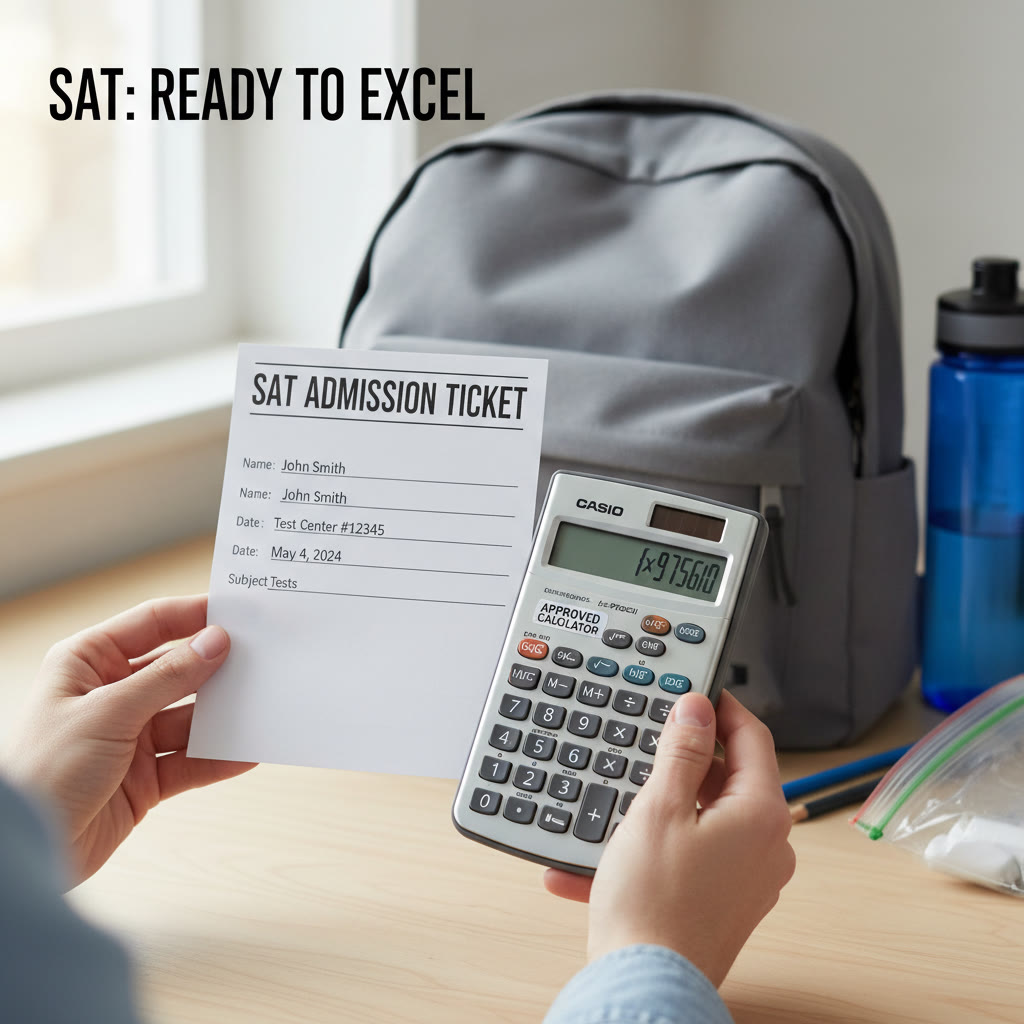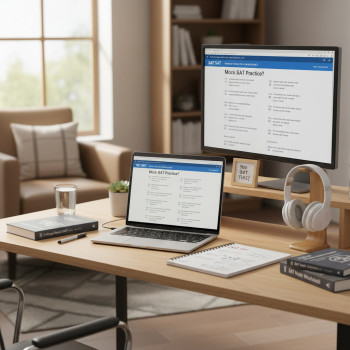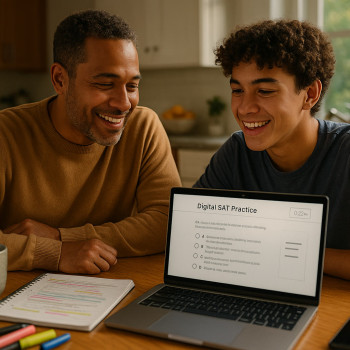Why the Retake Matters: One Smart Shot at an Ivy-Level Score
If you’re here, you already know two things: first, Ivy League schools have high expectations, and second, the SAT still carries weight in many admissions processes. But here’s the nuance: the Digital SAT—shorter, more adaptive-feeling, and administered through College Board’s Bluebook—changes the playing field. That’s good news. With a smart retake strategy, focused practice, and a little guidance, you can move from “average” to “competitive.” This post is for students and parents who want a calm, realistic, and actionable roadmap for the retake that respects busy schedules and builds confidence.
Quick reality check
Retaking the SAT is not a sign of failure—it’s a strategic decision. Many students improve substantially on a second (or third) attempt. The digital format often reveals strengths (shorter passages, a built-in calculator option, clearer visuals) that weren’t as visible on paper-based tests. Use that to your advantage.

How the Digital SAT Changes Your Retake Approach
Before we build a plan, understand the test. The Digital SAT keeps the same core skills—reading, writing, and math—but it delivers content differently: shorter standalone reading items (instead of long passages with multiple questions), more focused math-in-context items, and an embedded testing experience via Bluebook that includes an on-screen Desmos-type calculator and features like a pause-on-exit safeguard. These adjustments mean that test-taking stamina, navigation, and pacing strategies shift slightly.
Key practical takeaways for your retake
- Shorter reading items reward consistent, efficient comprehension—practice quick retrieval and single-passage focus.
- Math questions may be more concise: sharpen problem recognition and algebraic fluency rather than purely long-form algebraic manipulation.
- Bluebook’s embedded calculator options mean you should be comfortable switching calculator modes; practice using both the on-screen tool and a hand-held approved calculator.
- Technical safeguards (e.g., timer pause when exiting) reduce stress about tech glitches—but they also require you to be familiar with the interface before test day.
Step-by-Step Retake Strategy (12 Weeks)
This is a modular, evidence-informed plan you can compress or expand depending on how many weeks you have. The 12-week version balances review, targeted practice, and test simulation.
Weeks 1–2: Diagnostic + Planning
- Take a full-length, timed Digital SAT practice test using Bluebook or the official platform. Treat it like test day—same device, same environment, no distractions.
- Analyze the results by section and by content area: which reading skills (vocabulary-in-context, evidence-based inference), which math topics (linear equations, geometry, data analysis), and where timing broke down?
- Create a score target. For Ivy League goals, identify the median or 25th–75th percentiles for your target schools and set a realistic target (e.g., +50–+150 points, depending on your baseline).
Weeks 3–6: Focused Skill Work
Replace unfocused study time with concentrated drills. A “less-is-more” mindset wins here: fewer topics, higher mastery.
- Reading & Writing: Work on active reading strategies—predict, annotate (even if digitally), and answer the primary question type for each short passage. Reduce rereads by practicing one-question passages until you’re comfortably accurate at pace.
- Math: Master the high-yield topics where you lose points. If you miss arithmetic-of-algebra errors, slow down and re-scan for careless mistakes. Use the embedded calculator in practice so you’re fluent switching between modes.
- Timed drills: Do 20–30 minute sprints focusing on problem types that give you trouble (e.g., sentence completion, passage-based evidence, systems of equations).
Weeks 7–9: Strategy + Simulation
Now glue the skills into test-wielding strategies.
- Practice section pacing: refine how long you spend on individual items. On digital SAT, small time savings per item add up quickly.
- Develop triage rules: which questions to attack first, which to skip, and micro-decision rules for “when to guess.”
- Simulation tests: Take at least two full-length, timed digital practice tests under testing conditions. Learn how exits, breaks, and the on-screen tools feel in real-time.
Weeks 10–11: Polishing
This is precision work: consolidating gains, eliminating recurring errors, and rehearsing test-day routines.
- Review every missed question from your simulations. If a mistake repeats, make a specific plan to fix it—targeted mini-lessons, concept review, or tutor sessions.
- Simulate the test-day routine (wake time, breakfast, travel, device check). Practice under that rhythm so nothing surprises you on the real day.
- Reduce total study hours slightly to avoid burnout—quality over quantity.
Week 12: Taper + Test
Take it easy and confident. A calm mind performs better than an overworked one.
- Two light practice sessions early in the week—no heavy learning.
- Check Bluebook access, device battery, and calculator settings. Pack an approved hand-held calculator if you use one.
- Arrive early, follow your practiced routine, and trust the work you’ve done.
How to Use Data: Make Practice Smarter, Not Longer
Raw hours don’t matter as much as targeted feedback. The digital score report now offers richer insights into performance by content area—use these to allocate effort. For example, if your report shows stronger performance in algebra than in data analysis, prioritize practice sets and mini-lessons on interpreting graphs and statistics.
| Score Band | Focus Areas | Study Activities (per week) |
|---|---|---|
| Below 1000 | Foundational skills, pacing | 3–4 hours: core concept review, daily 20-minute drills, 1 practice section |
| 1000–1250 | Weak content clusters, test strategy | 4–6 hours: targeted topic work, 2 timed sections, 1 full test every 2–3 weeks |
| 1250–1450 | Precision, avoiding careless errors | 6–8 hours: advanced practice, full tests weekly, error log review |
| 1450+ | Maximizing range, high-value strategies | 5–7 hours: sharpening weaknesses, strategic guessing, mindfulness routines |
Use an error log
Every missed question is a gift. Log the question type, your error (content, careless, timing), and a 1–2 line correction plan. After ten entries in a category, do a focused mini-unit on it. This practice has a huge return on time invested.
Practice Tools and What to Prioritize
Official digital practice is best for familiarizing yourself with Bluebook features and how short reading items behave. Complement official materials with well-structured third-party practice when you need volume. But remember: practice must be mixed with analysis—time spent doing tests without reviewing mistakes is wasted.
When to add a tutor or personalized program
If your score plateau persists despite disciplined study, lean on targeted, one-on-one help. Personalized tutoring—especially programs that pair expert tutors with tailored study plans and AI-driven insights—can accelerate progress by diagnosing subtle patterns and holding you accountable. Sparkl’s personalized tutoring is an example of what this looks like: 1-on-1 guidance, customized study plans, and data-informed feedback can turn weak areas into reliable strengths.
Test-Day Habits That Win
Great test-day performance is equal parts subject mastery and emotional regulation. Develop habits that keep you steady.
- Night before: sleep early and avoid last-minute cramming. Your brain needs consolidation time.
- Morning of: hydrate, eat a balanced breakfast, and do a 5–10 minute warm-up (a few math problems, one short reading passage) to activate test thinking.
- Mindset cues: have a two-sentence mantra (e.g., “Read carefully. Trust my process.”) to reset after each break or tricky item.
- Device readiness: charge your testing device fully, bring charger or power bank if allowed, and make sure Bluebook is updated and practiced with beforehand.

How Parents Can Help Without Micromanaging
Parental support matters. The right kind of support is steady, practical, and empathetic.
- Provide structure: help set a weekly practice schedule and protect it from other activities.
- Be logistical: confirm registration, reminders, and transportation on test day.
- Be emotional: celebrate progress; avoid equating a single score with worth. Encourage rest and healthy routines.
- Invest wisely: if targeted tutoring or a personalized plan will clear a persistent hurdle, consider it an investment in the student’s future rather than an expense.
Real-World Example: From Average to Ivy-Competitive
Here’s a composite, realistic case showing how the plan plays out.
- Baseline: 1220 (650 Math, 570 EBRW) after a first attempt during junior year.
- Goal: 1400+ for a competitive application (target schools’ medians considered).
- Plan executed: 10-week focused program, 1 full digital practice test every 10 days, weekly error-log reviews, and two 1-on-1 tutoring sessions per week to target math fundamentals and reading strategy.
- Outcome: improved pacing and elimination of careless errors; after two formal retakes, final score 1440 (740 Math, 700 EBRW). This change opened conversations with reach and target schools in applications.
What made the difference? Data-driven focus—hone in on repeated error types—plus consistent full test simulations, and a tutor who coached test-wielding strategies rather than broad content review. That’s the value of personalized, expert support.
Balancing the SAT with the Bigger Application Picture
Don’t lose sight of the entire application. Ivy League admissions are holistic. Strong grades, compelling essays, authentic recommendations, extracurricular impact, and demonstrated intellectual curiosity matter alongside SAT results. Use retake gains to complement your narrative: improved scores can boost scholarship options, open discussion in interviews, and increase confidence—just don’t treat the SAT as the single determinant.
Where your SAT gains help most
- Early decision/early action applicants often benefit from a strong score in initial review rounds.
- Scholarships and merit-based considerations sometimes have cutoff or average thresholds.
- Score improvements demonstrate growth and maturity—use that storyline in essays or interviews if relevant.
Common Retake Pitfalls and How to Avoid Them
- Overpractice without review: doing more tests without analyzing errors leads to plateaus. Always pair practice with targeted review.
- Chasing unrealistic jumps: aim for steady, measurable progress (20–80 points per month is realistic for many students depending on starting point).
- Neglecting test-day interface practice: the Bluebook environment feels different—practice in it so you’re not surprised on test day.
- Burnout: schedule deliberate breaks and taper your study in the final week to arrive fresh.
Final Checklist Before You Retake
- Practice tests: at least two full-length digital practice tests in the month before test day.
- Error log: reviewed and acted upon; recurring error types addressed with mini-units.
- Device prep: Bluebook updated, account tested, and charger packed.
- Daily routines: sleep schedule and light exercise leading up to the test—no late nights the week before.
- Support lined up: transportation, snacks, and a calm parental presence.
When to Consider Professional, Personalized Help
If progress stalls or you need a higher ceiling for an Ivy application, a personalized tutoring program can provide targeted curriculum, pacing accountability, and expert coaching on test strategy. Look for tutors who:
- Diagnose with data, not impressions.
- Create a tailored study plan focused on your highest-return weaknesses.
- Offer regular progress checks and simulated testing under Bluebook conditions.
Sparkl’s approach—1-on-1 guidance, customized study plans, and AI-informed insights—fits this model well: it combines human expertise with data to deliver focused practice and clear progress markers without overwhelming the student’s schedule.
Parting Advice: Make the Retake a Smart, Calm Step Forward
Retaking the Digital SAT is an opportunity to improve not just your numbers, but your confidence and your application story. Use the digital format to your advantage, treat every practice item as a lesson, and build a plan that fits your life. With steady work, analysis, and the right support, it’s entirely possible to beat the average and step into your applications with a score you’re proud of.
Want a next step?
Start with one honest practice test in Bluebook this weekend. Log your errors. Build a two-week plan focused on the two weakest areas that emerged. If you want help making that plan and turning it into a measurable improvement, consider a short block of 1-on-1 coaching to accelerate learning and give you the confidence to perform when it counts.
Good luck—study smart, rest well, and trust the process. The retake is your strategic move; make it intentional.




















No Comments
Leave a comment Cancel